
Tackling a complex project can feel overwhelming—where do you even start?
Whether you’re managing a large team project, planning an event, or even organizing personal goals, mind maps are a powerful tool that help you break down these big projects into manageable pieces in 5 steps, identifying the project scope, setting phases or milestones, breaking tasks, setting priorities, and tracking progress. By visually mapping out the structure of your project, you can see the full scope, identify dependencies, and make clear decisions about priorities.
In a previous article we saw how to plan your day with mind maps and that was task management. In this article, I’ll show you how to mind map a project with a step-by-step guide to simplify even the most complicated projects and turn them into achievable milestones. Ready to get started?
Content Covered Today:
Why Use Mind Maps for Project Management?
There are various benefits for making mind maps for projects:
1- Visual:
Mind maps offer better visualization to the mapped information through having everything in one page, using colors, connecting map parts together, inclusion of visual clues to map parts like icons or sketches, and of course, the end result of the mind map itself serves as an image formed of connected bunch of keywords.
2- Structure:
Mind maps offer a practical structure to the project being managed through highlighting its key aspects in the main branches. With tasks as discussed in a previous article (put link), this categorization varied from context, nature, persons and more. With project management on the other hand, I tend to see the most practical way of categorizing the project is per its phases. Meaning, the main branches of the project management mind map will have phase 1, phase 2 and so on.
That being said, you still have the freedom to mind map the project differently, like creating a project mind map with assigned responsibilities so you’ll have the main branches as persons names and their responsibilities. You can do it chronologically in time as in moths or quarters, so you’ll have the main branches as quarters for example and what needs to happen in each quarter.
3- Freedom:
Mind maps in general offer high level of flexibility to create the mind map as suits you without any restrictions, and this is true even for project managements and I think you have tasted that with the previous point, structure, when we gave examples of how can you go about mind mapping your project.
4- Collaboration:
Another key benefit of mind mapping is the ability of project teams to collaborate in a single mind map, interact with it and use it to simplify other related tasks like using it for presenting the project and its status to key stakeholder.
Now that I clarified the benefits of incorporating mind mapping into project management and the outcomes you’ll gain from having your project in a mind map, I’ll now go through the 5 steps to create an effective project management mind map.
If you have a project in mind and you need to try planning it with a mind map with me, then have a pen and 3 papers (you’ll find out why) and let’s do it together.
Step 1: Define the Scope of Your Project
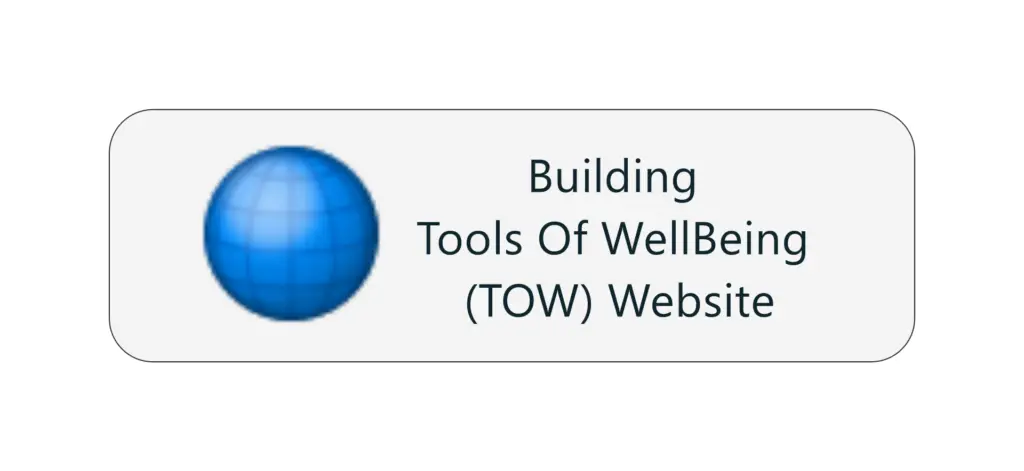
The first step of creating a mind map for project management is defining the scope of that project in as a central idea. This is where your focus will be on for the rest of your project planning and management so it has to be done right. Otherwise you’ll be planning and managing the wrong outcome.
When we discussed task management mind mapping, the central topic was more about tasks themselves, like “send top priority emails” or “make the 5 needed calls” or “finish 14 tasks today”. With project management on the other hand, I always advise to include the overall outcome of the project as the central topic. Why? It will boost your focus towards the real outcome and purpose of the whole project and not deviate from it.
Examples include:
- Increase sales by 10% in 2Q
- Improve employees moral by 25% in 3Q
- Acquire 3 big clients by 3Q
- Building the website
As you can see from examples above, they’re not about the tasks themselves. There’s no mentioning of the emails to be sent or calls to make or meetings to attend. It’s all about the target of the project.
Another project management tip to help you come up with the best mind mapping central topic is to have a S.M.A.R.T outcome (S-specific, M-measurable, A-attainable, R-realistic, T-time bounded) as illustrated in the above example.
Once you come up with the project outcome, now it’s time to put it on the mind map and you can do it by any means you love:
- You can simple write it down and circle it
- You can sketch or draw something that means it. An upward arrow for “increase”, a $ for “sales” and 2Q or 4 quadrant circle with the 2nd one colored to represent “2Q”. A happy employee with his thumbs up next to an upward arrow with 25% written on it and 3Q for 2nd outcome example above. You get the idea.
Take a moment to come up with the best project outcome to use as the main idea of your mind map, and then put it in the center of the page you have using any of the ways I shared above. Don’t over kill it, with mind mapping, you always have the freedom to modify.
Step 2: Identify Project Essentials
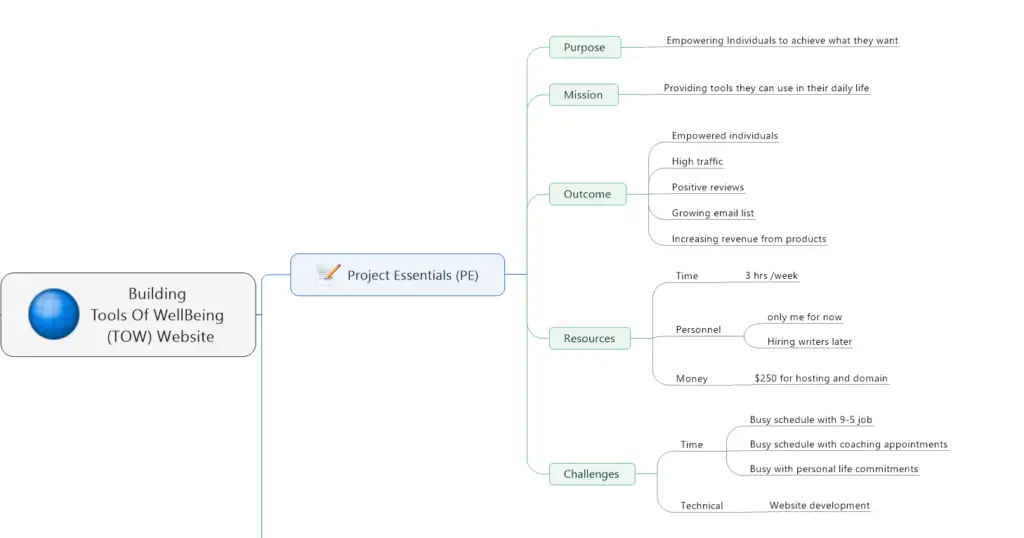
After choosing your project scope carefully and make it into the center of your project mind map, most people jump straight to planning the phases or milestones of the project but you’re not like most people right?
When I coach about creating a project management mind map, I always train clients to come up with key information about the project I call “project essentials”. Let me share them below with questions I use in my coaching and why you have to identify those prior to doing the planning itself:
1- Purpose of the project:
| Coaching Question: | Why you are having/doing/creating this project? |
| Examples: | “to support individuals”, “to create high quality service”, “to increase sales”, “to improve employees moral” |
| Importance: | Knowing the purpose of the project increases your focus and drives your motivation to completing it. Most always it’s going to be one purpose for each project. If you have come up with more than one purpose, try asking more “why” questions for each purpose till you come up with one overall purpose. If you still have more than one purpose that you can’t combine in one larger purpose, then I advise you to make a project mind map for each one separately. |
2- Mission(s) of the project:
| Coaching Question: | How you are going to achieve the purpose of your project? |
| Examples: | “to provide more customer service agents”, “to train or recruit trained call center agents”, “to increase shifts”, “making workplace more enjoyable”, “revising workplace policies” |
| Importance: | This will give your more clarity on the main action(s) you’re going to focus on the entire project. Remember that a project can have more than one mission and you need to include them all. Sometimes each mission will require having its own project mind map if you see fit, otherwise you can incorporate all missions for the same project in one mind map. |
3- Outcome(s) of the project:
| Coaching Question: | What are you going to achieve with your project? |
| Examples: | To have “higher NPS score”, “more positive reviews”, “more sales”, “more positive moral rating”, “increased employees retention”, “higher stock value” |
| Importance: | Knowing the outcome of a project makes you see the finish line and what the world should look like by the end of it. It’s like you’ve time traveled to the future and saw what it looks like 6 months from now, and now you’re back to fulfill that destiny. |
4- Resources of the project:
| Coaching Question: | What does the project needs and you have? |
| Examples: | “6 hours a day”, “3 persons”, “$4000”. It’s almost always will come down to the 3 basic resources of time, personnel and financial resources |
| Importance: | Knowing what you have in place already makes you at ease and drives motivation to proceed |
5- Challenges of the project:
| Coaching Question: | What you think can or will stop you during the project management? |
| Examples: | “economical problems”, “geopolitical problems”, “natural problems”, “new competition”, “absenteeism”, “sickness” |
| Importance: | knowing the challenges that might arise prepares you to think of ways to overcoming them if they took place in reality. |
Those are essential details you should come up in your mind map for your project, and you can either create a separate branch for each point above or make one branch called PE (project essential) and sub branches radiating from it. Their importance in my coaching made me include them in the Multi Projects Management Notebook I created for handling up to 25 projects.
Step 3: Identify Key Phases or Milestones
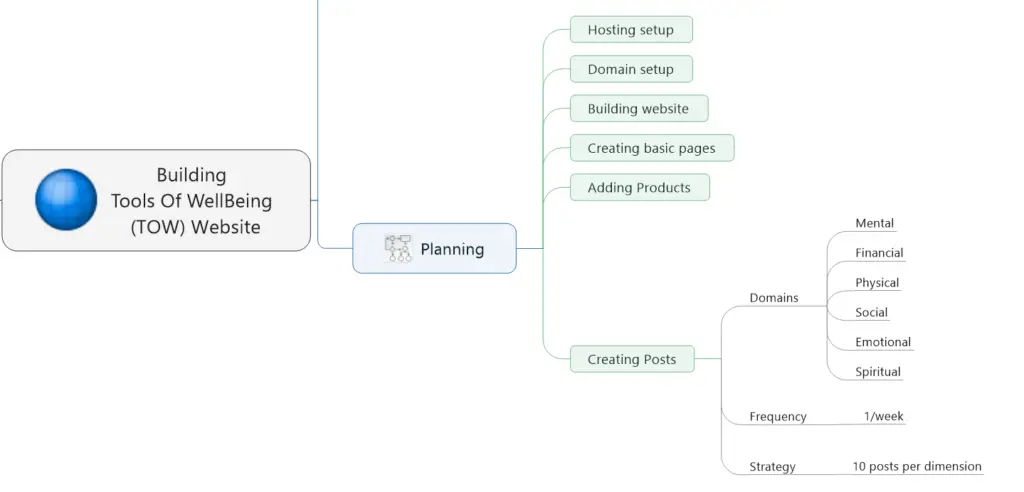
Now it’s time to break down the project into smaller pieces and as explained earlier in the “structure” point, you can go about it in any way you see fit, and I mean anyway, that’s the beauty of mind mapping.
However, when I coach people on how to make a mind map for a project planning, I advise to have it by phases or milestones of the project. For me, I see this is the best way to mind map a project because:
- You can see the overall project parts that need to move, when, by whom.
- You can simply track project progress by seeing which part(s) are complete, which are ongoing and which are behind.
- This is the most common way of thinking when people think about projects, they think it through phases as in what needs to happen then what and so on. This will make it easier for you to communicate it to other team member, stakeholders and other people related or interested to it, rather than going about it by quarter or responsibilities.
To come up with the main phases, you need to step away for a minute from your mind map as we’ll do a quick brainstorming first. To do that, you just use another empty paper, write down the project outcome in its center as you’ve done before, then all you need to do is add “anything” that needs to happen within that project.
You aim for quantity here, write down anything you think of whether it’s small or big, low or high important, low or high relevance, smart or stupid, you’ll do it or others, etc. The goal of this exercise is to come up with all of the tasks that we can think of for this project.
You can finish this step in one setting or several and this is why in my coaching, I always advise clients to spend few more days on this brainstorming task as new ideas might appear spontaneously or they simple ask other team members if they have more ideas to include.
Once you think you have a relatively complete list of ideas and thoughts, you start identifying main phases and their order. This can happen easily if you see a clear organized flow of phases like (approvals – purchase – design – market – sell – follow up) for example. Or you’ll have to look for patterns to come up with ordered phases for your project.
Once you have identified your project milestones, you can simply go back to your mind map and create branches for those main milestones.
It’s your turn now. Use one of the other empty 2 papers, copy the project outcome in its center, start brainstorming for about 30 minutes, then spend about 10 more minutes to come up with main milestones of your project.
Step 4: Break Tasks into Manageable Chunks
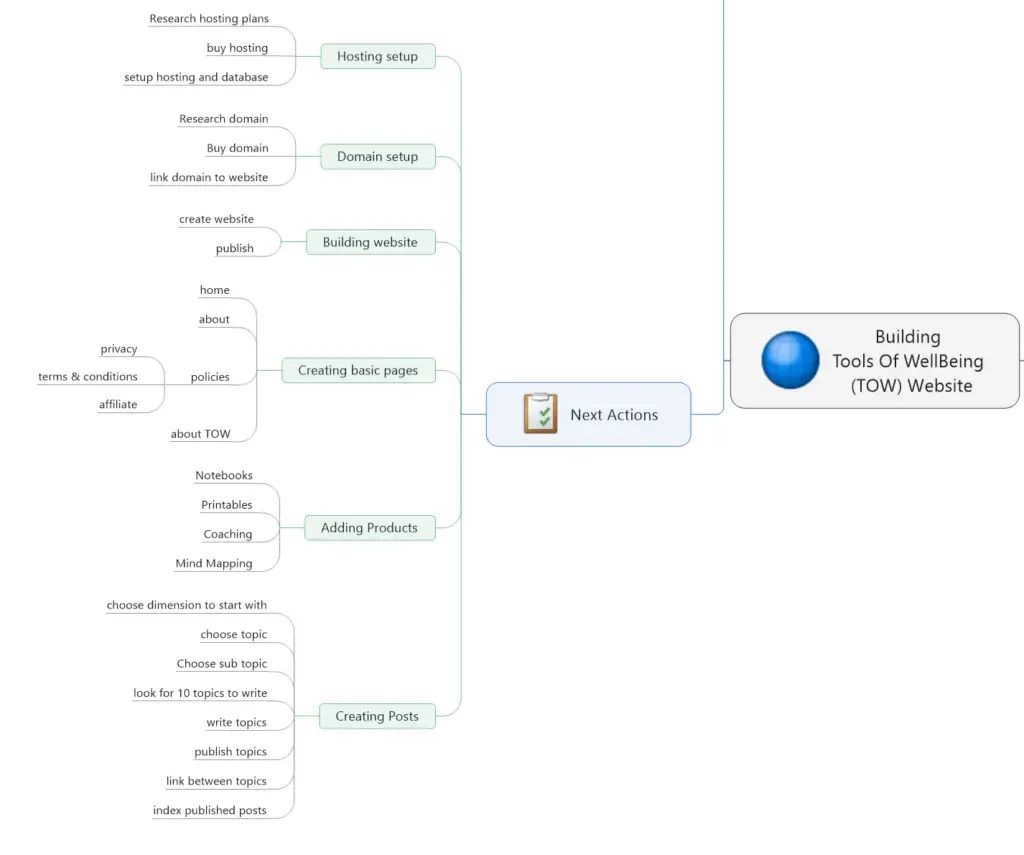
Once you have created the main branches of your project, it’s time now to break each phase or milestone into manageable pieces. Having “approvals” in one branch doesn’t mean anything, and it only adds vagueness to our minds.
That’s why, we need explain further what do we mean by “approvals”. For this we can include everything that helps including points like actions, timing, responsibilities, resources, challenges, risks, etc. Let me share couple of examples of that the sub branches of the “approvals” branch might look like:
- Jack to send last year budget-today
- Sarah to inquire about new prices-today
- Mark to create presentation-tomorrow
- Email team and CFO to schedule a meeting next week for budget approval-tomorrow
In the above list you can see actions need to be taken, responsible person(s), and when it’s due to meet overall project timeline. The above content vary according to project’s context. Personal projects for example won’t have other responsible persons. Small projects might not need risks identification unlike big projects where you need to plan ahead for risks might happen. Small projects might not need as many resources as big projects needing X personnel + X money + X working time, etc.
Take few minutes now to come up with all tasks in each branch. For each one you need to clarify who’s the responsible person(s), if any, and when you need them to happen.
Step 5: Set Priorities and Dependencies
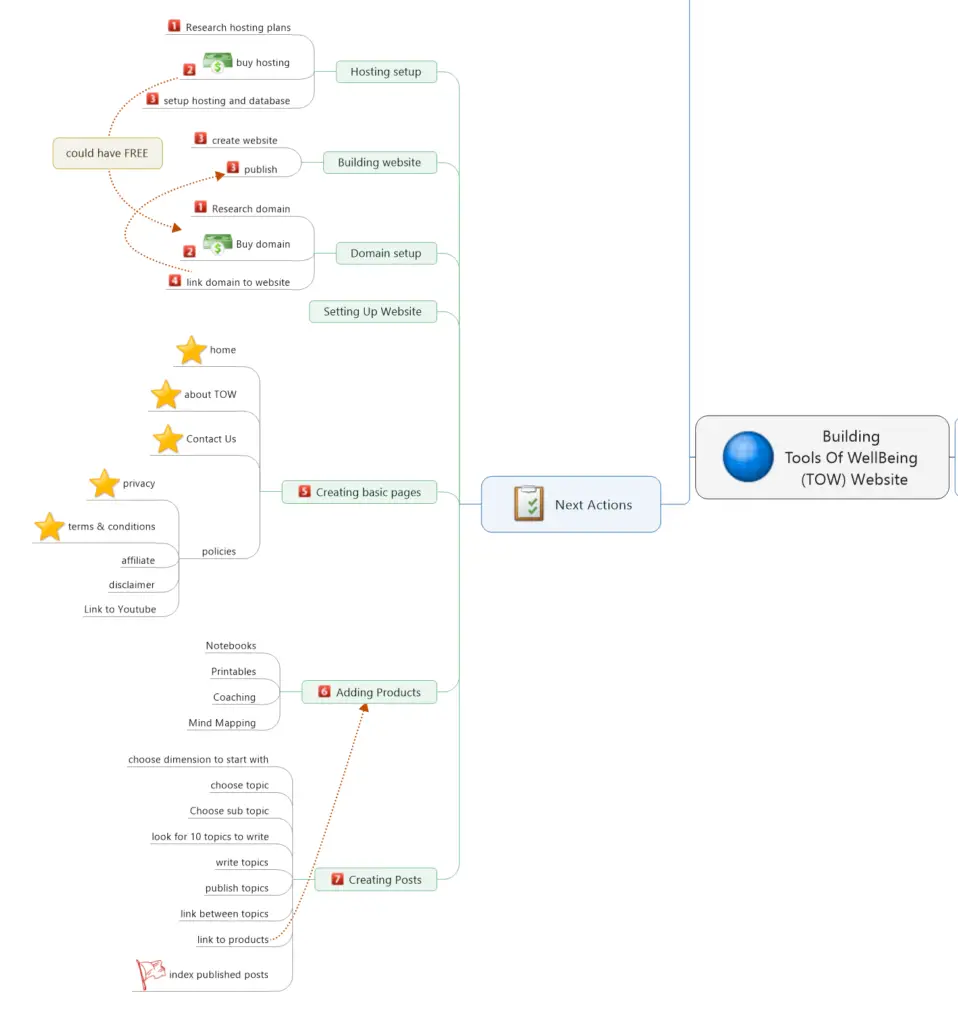
At this step your mind map is kind of complete and you can stop reading further and start working on your mind map. But if I’m coaching you, I’ll strongly recommend that you complete this step as well. As we agreed, one of the mind mapping benefits is the powerful visual representation through visual clues and connections.
When we talk about project management, this translates into adding visual clues that represent anything like:
- Priorities of tasks by adding a star or a flag for example.
- Dependencies upon one another by using arrows to mean that task B can’t happen until task A is finished.
- Ownership by adding initials of the person or even his/her photo in digital tools.
- Size of tasks by adding a weight icon or sketch. You can have “write report” as one of your tasks and according to the report, it can be written in few minutes or few hours, so it’s good to help your future self-knowing that this task is going to take a lot of time so you can better choose timing to complete it.
As you can see it’s very small step of adding few icons or couple of arrows, but it has a huge benefit to the effectiveness of your overall project management mind map that makes it more structured, more manageable and more memorable in case you needed to present it.
Your turn, take few minutes to highlight key tasks or phases as important and look for dependencies between tasks to help you strategize which tasks you need to tackle first.
Step 6: Tracking Progress with Mind Maps
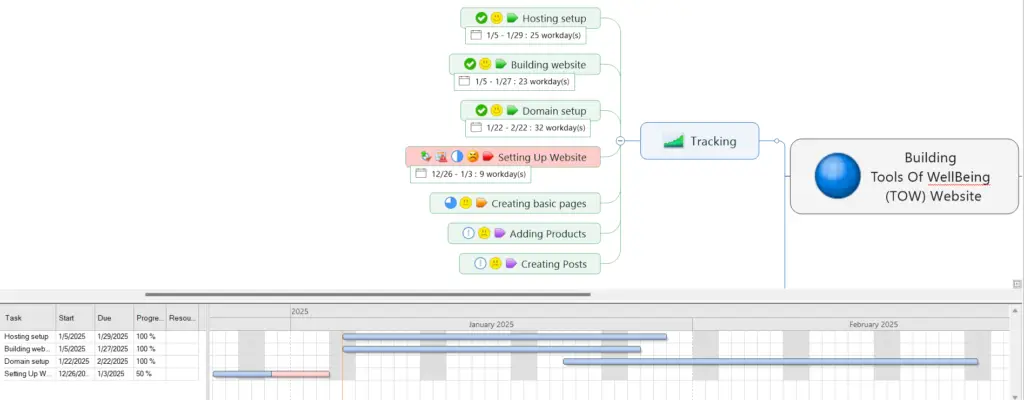
“You can’t improve what you can’t measure” This is one of my favorite quotes of all time. This holds true for projects as well. If you don’t know the distance between your current position and your destination, you won’t have any idea of how close or far you are from it.
That’s why it’s crucial that you don’t stop your project management when you finish planning it. You have to periodically check your current position compared to your destination. Are you getting closer? If yes that’s fine, keep going. If not? Then why not? What’s holding you back? What can you do about them?
Mind maps are great with tracking your project progress since you categorized it by phase, it’ll make it easier for you to see how much is done and how much is left. A mind map with 4 phases for which you have finished 2 is 50% complete.
You can also get creative in representing this like by coloring a portion of the central idea every time you finish a phase, or you can add a small 0-100% line tracker under the central idea and color 10% or 50% of it according to your status.
I can’t emphasize it enough, but tracking your project is as important as planning it in the first place so make sure not to skip on this step. I usually advise tracking your progress weekly since you’ll be more relaxed not missing out on anything and it will tie with your weekly review to your overall productivity system.
I will leave you at this step knowing that you already have a powerful mind map for your project and what’s left now is for you to take actions then next week use the same mind map to track your progress using any creative way that suits you.
I told you to have 3 papers in the beginning of this article and so far we only used 2, one for the mind map and another for brainstorming main branches and tasks. The final paper is for taking whatever content, icons and connections you came up with and creating a neat mind map of the same project to be used onward.
Tools to Use to Make Mind Maps for Projects
Whatever we discussed so far can be simply done by a pen and a paper like what you did here, and if you’re interested in knowing couple of other tools then check the “best X mind mapping tools” article where I share best tools, pros, cons, pricing, etc. (put link) Here I’ll just share what I currently use:
1- MindManager
Powerful tool that is ideal for managing complex projects and tracking progress through the mind map itself and the Gantt chart feature that tracks the progress of the tasks in the mind map. It’s what I used for the pictures in this article.
2- Mind Mapping Notebook
A simple and portable mind mapping notebook that I designed to be used physically anywhere. It is originally designed for beginners and that’s why it has a brief guide about mind mapping, 50 blank mind map templates to practice and a lot of blank pages to mind map freely.
Conclusion:
Using mind maps to break down complex projects makes them more manageable, allowing you to organize tasks, set priorities, and track progress visually. Whether you’re tackling a large-scale business initiative or a personal project, mind mapping is a flexible tool that can adapt to your needs. Digital tools like MindManager provide excellent functionality for large teams, while the Mind Mapping Notebook is perfect for those who prefer a hands-on, paper-based approach.
Start breaking down your next complex project with a mind map and see how it can transform your workflow!